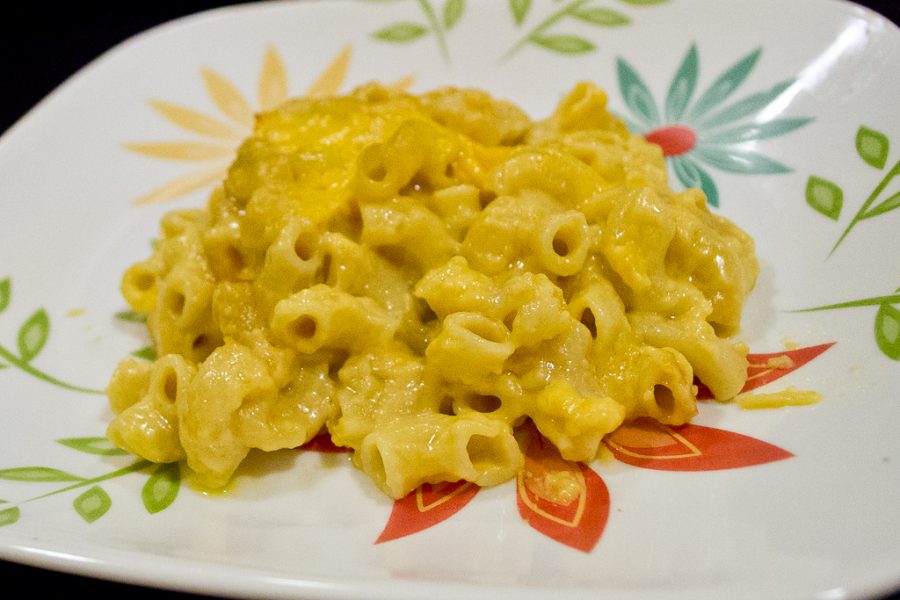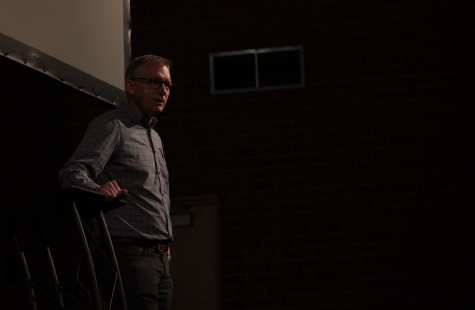Getting ready for autumn: baked macaroni and cheese
Anna Frost shows us how to make one of the most classic dishes: baked macaroni and cheese.
This baked macaroni and cheese provides a taste of home cooking as fall approaches. | Ashleigh Fox/THE CHIMES
October 18, 2012
With fall approaching and thunderstorms passing through, indulging in the gooey goodness of macaroni and cheese seemed the right thing to do.
Macaroni and cheese is wonderful for a few reasons: It involves cheese, reminds us of childhood, it is warm and cozy like a blanket on a rainy day, and of course, cheese. An extremely versatile dish, macaroni and cheese can be simple or dressed up and decadent. Whether you decide just to use cheddar or get fancy and incorporate complementary cheeses, it is always delicious. Macaroni and cheese is also a fantastic place to put leftovers, such as meat or vegetables, that would otherwise sit in the fridge until they crawl out and scare your roommates. Just chop them into bite-sized pieces and toss them into the sauce with the pasta.
Baked Macaroni and Cheese
1/2 pound elbow macaroni; this is about 1 3/4 cups small macaroni, or 2 1/2 cups large macaroni
3 tablespoons flour
3 tablespoons butter
3 cups milk
3 cups cheddar cheese, shredded
salt
pepper
Preheat the oven to 350 F.
Fill a large pot, at least four-quart capacity, 2/3 full with water. Toss in a few large pinches of salt. Heat water to a full, raging boil over high heat; placing the lid on the pot will help the water boil quicker.
Once the water is boiling, add the elbow macaroni and stir to prevent clumping. With the lid off, let the water come back to a full boil. After six to eight minutes, check the macaroni by biting a piece in half. If done, the pasta will be soft enough to bite into, but will still retain a firm texture. However, it should not be crunchy nor mushy. In the center of the macaroni, a thin white ring should be visible. This stage of cooked pasta is called al dente, or “to the bite.” Although this may seem like an insignificant distinction, it is actually beneficial to the texture of the dish and to your health.
Pasta cooked to al dente has a lower glycemic index than pasta over-cooked to the ultra-soft texture many cooks mistake as done. The glycemic index measures how much a carbohydrate food — such as breads, vegetables or fruits — raises one’s blood glucose, or sugar, levels. As a key tool in preventing major health issues such as obesity and Type 2 diabetes, this is not information to take lightly. Since white pasta, as opposed to whole wheat pasta, is composed primarily of simple carbohydrates that rank high on the glycemic index, it is important to cook it to al dente. By lowering the index rating, your body will digest the pasta slower. This slows down the absorption rate into your blood glucose and you will feel fuller longer.
If you have another pot, at least two quarts, start on the cheese sauce while the pasta cooks. If not, use the same pot after the pasta has finished cooking.
Either way, pour the pasta into a colander once it has finished cooking. Rinse with cold water to prevent macaroni from sticking, as well as to halt any carry-over cooking.
Put the pot you intend to use for the sauce on medium heat and melt the butter. Whisk in flour well, eliminating all lumps, to create a rue. This rue, equal parts butter and flour used as a thickening agent for sauces, will be the most important step in making the sauce for the macaroni and cheese. If the rue is not cooked enough, the cheese sauce will taste like raw flour. Stirring occasionally, cook the rue to a light golden color. It should give off a soft, nutty aroma as it reaches this point, which will take about 5 minutes.
When the rue is ready, add all of the milk as well as pinches of salt and pepper, whisking until smooth. Let this mixture come to a boil, whisking occasionally so that the sauce does not stick and burn. When the sauce comes to a boil, it will be noticeably thicker than the thin milk with which you began. Congratulations, you have successfully made bechamel sauce, which is the French term for white sauce. Bechamel sauce is made by thickening milk with rue and is usually the base for any macaroni and cheese worth eating. Take your finished bechamel sauce off the heat and stir in 2 1/4 cups shredded cheese until completely melted and smooth. If it does not melt completely after a few minutes, return to the burner on medium-low heat until the sauce is homogeneous.
Pour macaroni back into the finished sauce and stir until coated evenly. Pour half into a lightly greased 9×13 inch pan and evenly create a middle layer with most of the remaining 3/4 cup of cheese. Pour the rest of the macaroni on top and sprinkle with the rest of the shredded cheese. Put in the oven for 30 minutes, or until the sauce is bubbling and the cheese on top is melted.
Let rest for five minutes before serving to friends, family or random hungry people hovering about the magnificent, nostalgic scent of macaroni and cheese wafting around the dorm lobby.






